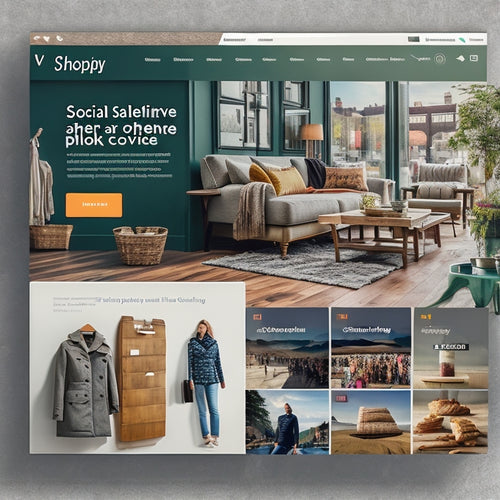
Revolutionize Your Ecommerce: Inventory-Free Success Strategies
Share
To revolutionize your ecommerce, ditch traditional inventory models and focus on growth. Inventory-free business models like print on demand and dropshipping eliminate upfront costs and storage needs. Next, build a website that showcases your products and converts visitors into customers. Choose a platform that integrates with your business model, and optimize for mobile. Develop a marketing strategy that targets your niche audience and showcases your unique value proposition. Nurture leads with compelling email campaigns, and expand your reach through social influencers and high-quality content. Now, get ready to take your ecommerce to the next level by leveraging these strategies.
Key Takeaways
• Adopt inventory-free business models like Print on Demand (POD) and Dropshipping to minimize upfront costs and storage needs.
• Choose products aligned with your niche, verify high-quality and in-demand products, and create a visually attractive and easy-to-navigate website.
• Select an eCommerce platform that integrates with your business model, set up secure payment gateways, and ensure mobile optimization.
• Develop a robust marketing strategy targeting your niche audience, showcasing a unique value proposition, and leveraging social influencers and high-quality content.
• Optimize your website for conversions and SEO to improve visibility, drive organic traffic, and nurture leads with compelling email campaigns.
Inventory-Free Business Models
When it comes to building a successful eCommerce business without holding any inventory, you have several innovative business models to choose from, each with its unique benefits and drawbacks.
Print on Demand (POD) is one popular option, offering advantages like minimal upfront costs and no storage needs. However, it also has its cons, such as limited product customization and potential quality control issues.
On the other hand, dropshipping can be highly profitable, but it comes with challenges like managing supplier relationships and dealing with shipping complexities.
Building Your Online Store
Now that you've selected an inventory-free business model, it's time to set up your online store, which will serve as the foundation of your eCommerce venture. This is an important step, as a well-designed store can make or break your online business.
Here are some key considerations to get you started:
-
Choosing products: Select products that align with your niche and appeal to your target audience. Verify they're high-quality and in demand.
-
Website design: Create a visually attractive website that's easy to navigate and optimized for conversions.
-
Platform selection: Choose an eCommerce platform that integrates with your business model, such as Shopify or WooCommerce.
-
Payment gateways: Set up secure payment gateways to facilitate smooth transactions.
-
Mobile optimization: Confirm your website is mobile-friendly to cater to the majority of online shoppers.
Marketing and Growth Strategies
To drive traffic, boost sales, and establish a strong online presence, you'll need to develop a robust marketing strategy that targets your niche audience and showcases your unique value proposition.
This involves crafting compelling email campaigns that nurture leads and encourage conversions. Leverage social influencers who align with your brand values to expand your reach and credibility.
Consistently create high-quality content that addresses the needs and pain points of your target audience. Optimize your website for SEO to improve visibility and drive organic traffic.
Frequently Asked Questions
How Do I Handle Product Returns Without Holding Any Inventory?
"Ah, the joys of no inventory! When customers return products, you're not stuck with them. You simply forward the issue to your supplier or print-on-demand partner, and let them handle the refund process, while you focus on keeping customers happy."
Can I Use Multiple Inventory-Free Business Models Simultaneously?
You can definitely use multiple inventory-free business models simultaneously, leveraging cross-promotion opportunities and supply chain optimization to maximize profits, while minimizing risks and streamlining operations for a more efficient and safe online business.
What Payment Gateways Support Inventory-Free Transactions?
You'll find that PayPal, Stripe, and Square support inventory-free transactions, offering fraud prevention strategies like card verification, address validation, and IP blocking to guarantee secure online payments for your business.
How Do I Ensure Product Quality Without Physically Inspecting Items?
You're skipping the warehouse walk-through, but still need to guarantee quality. You can't touch, but you can still trust. Use remote inspection, implement quality control measures, and rely on third-party verification to guarantee products meet your standards.
Are There Any Inventory-Free Business Models Suitable for B2B Sales?
You can explore inventory-free business models for B2B sales through dropshipping partnerships, where you partner with suppliers, or virtual wholesale transactions, allowing you to focus on sales while leaving inventory management to others.
Related Posts
-

Boost Sales and Trust With Top Social Proof Apps for Shopify
This article explores the potential of social proof apps in enhancing sales and trust on Shopify stores. Social proo...
-

Does Shopify Have SEO Optimization
This article examines the extent to which Shopify offers SEO optimization capabilities. The objective of this analys...
-

The Power of Personalized Content
The power of personalized content is a topic of interest that delves into the advantages and difficulties associated...


